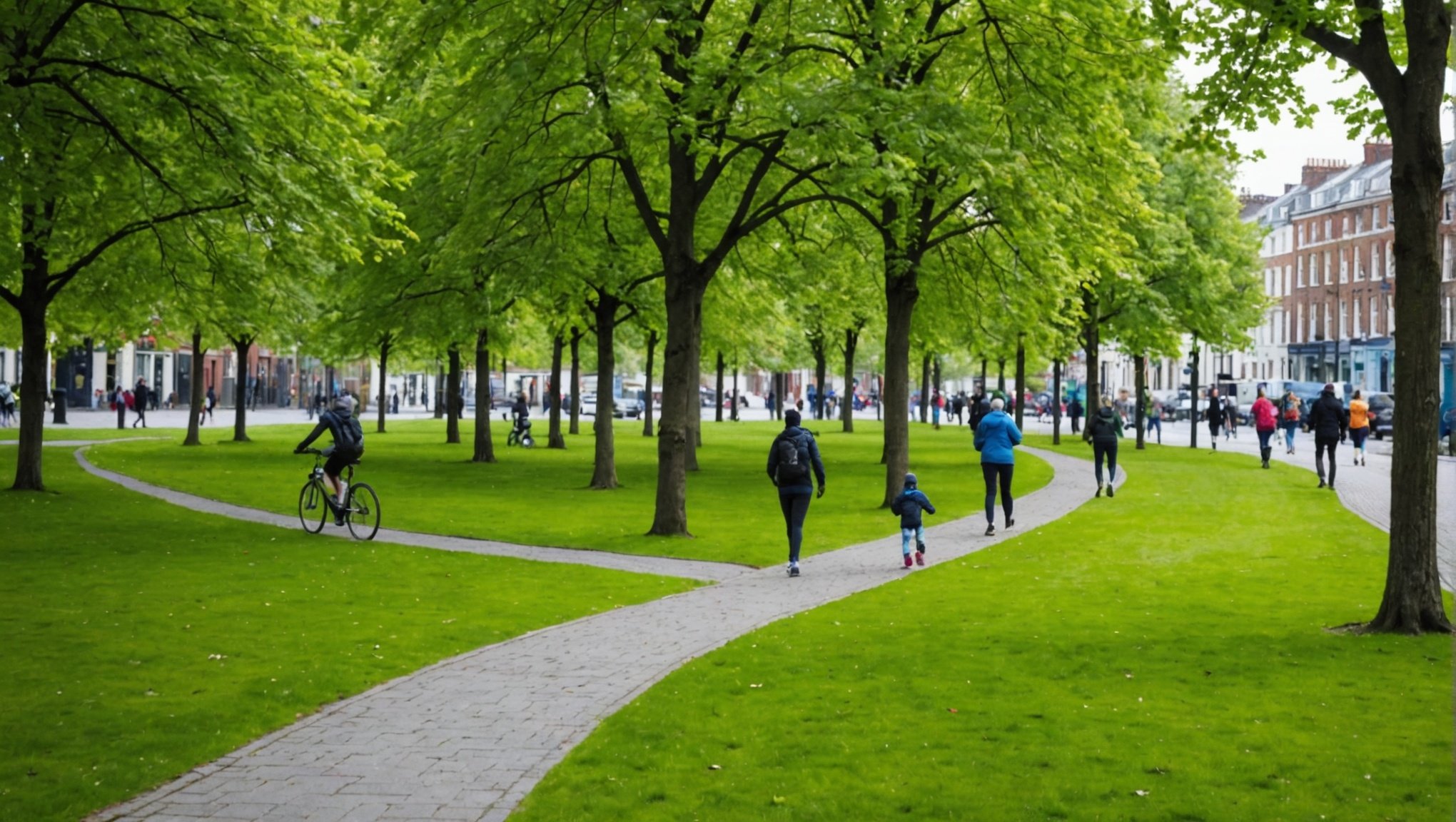Urban health is on the rise, thanks to the pivotal role of green spaces in promoting physical fitness across UK cities. Parks and gardens not only provide a breath of fresh air but also encourage active lifestyles and community interaction. As urban areas expand, integrating more green spaces can significantly improve public health outcomes. Explore how cities are transforming their landscapes and fostering healthier populations through the revitalization of urban environments.
The Relationship Between Green Spaces and Physical Fitness
In recent years, research has increasingly highlighted the importance of green spaces in promoting physical fitness. Studies suggest that individuals who have regular access to green spaces, such as parks and gardens, are more likely to engage in physical activities. This is particularly crucial in urban areas where exercise opportunities may be limited.
Also to discover : The Impact of London”s Public Parks on Physical Activity Among Seniors: Exploring Wellbeing for Elderly Residents
The psychological benefits of green environments play a significant role in enhancing exercise motivation. Being surrounded by nature can reduce stress and increase feelings of well-being, making exercise more enjoyable and less of a chore. This, in turn, encourages individuals to maintain a regular fitness routine.
Moreover, the impact of access to parks on physical activity levels cannot be overstated. Urban health is significantly improved when residents have easy access to green spaces. These areas provide a safe and inviting environment for various physical activities, from walking and jogging to more structured exercise routines.
This might interest you : Optimal Frequency of Eye Exams for Computer Users in the UK: A Key to Preserving Vision Health
- Green spaces offer:
- Aesthetic and calming environments
- Opportunities for social interaction
- Spaces for recreational activities
In summary, the availability and quality of green spaces are critical factors in promoting physical fitness and enhancing urban health. By investing in and maintaining these areas, cities can improve the overall well-being of their residents.
Benefits of Urban Parks and Gardens
Urban parks and gardens offer a plethora of benefits that extend beyond just physical activity. Regular use of these green spaces significantly contributes to community health by providing a natural setting for exercise, which can lead to improved cardiovascular health and reduced obesity rates. The presence of parks encourages residents to engage in physical activity, whether it's a brisk walk, a jog, or a leisurely stroll, thereby fostering a healthier lifestyle.
Furthermore, parks play a pivotal role in promoting social interaction and enhancing community well-being. They serve as communal hubs where people can gather, interact, and build relationships, which strengthens the social fabric of urban areas. The opportunity for social engagement in these settings can lead to increased feelings of belonging and reduced feelings of isolation.
Investing in urban parks and gardens also presents substantial economic advantages for cities. Well-maintained green spaces can increase property values, attract businesses, and boost tourism, all of which contribute to the local economy. Additionally, parks can reduce urban heat, improve air quality, and provide habitats for wildlife, further enhancing their value to urban environments. The multifaceted benefits of parks make them indispensable assets for cities aiming to improve overall community health and well-being.
Case Studies from UK Cities
Exploring UK urban green spaces reveals insightful case studies that highlight the transformative impact of city planning. In London, the creation of the Queen Elizabeth Olympic Park stands out as a successful initiative. This vast green space not only rejuvenated a previously neglected area but also enhanced community health by providing extensive recreational facilities. The park's design encourages diverse physical activities, from cycling paths to open fields for sports, showcasing how thoughtful planning can integrate green spaces into urban life.
In Manchester, the introduction of the "Green Streets" programme significantly improved public health. By converting underutilised areas into vibrant parks and gardens, the city has seen a notable increase in physical activity levels among residents. This initiative underscores the importance of accessible green spaces in promoting well-being.
Smaller cities like Bristol and Nottingham also offer compelling examples. Bristol's commitment to expanding its urban green spaces has led to improved air quality and increased community engagement. Meanwhile, Nottingham's investment in parks has boosted local biodiversity and provided residents with essential recreational areas. These case studies demonstrate the profound benefits that strategic planning of urban green spaces can bring to cities of all sizes.
Relevant Research Studies
Understanding the health effects of green spaces requires examining key research studies. These studies consistently demonstrate the positive impact of green spaces on physical health. For instance, research shows that proximity to parks correlates with increased physical activity levels, which in turn reduces obesity rates and improves cardiovascular health.
Longitudinal studies tracking fitness in urban populations further highlight the importance of green spaces. These studies follow individuals over time, providing robust data on how access to green environments influences exercise habits and overall health outcomes. Findings indicate that individuals living near well-maintained parks are more likely to engage in regular physical activities, contributing to better long-term health.
Public health reports underscore the role of urban planning in enhancing community well-being through green spaces. These reports advocate for the integration of parks and gardens into city landscapes as a strategy to combat urban health challenges. By incorporating green spaces into urban planning, cities can promote a healthier lifestyle among residents and improve public health metrics. The evidence from these studies and reports strongly supports the development and maintenance of urban green spaces as a public health priority.
Actionable Insights for Urban Planners
Urban planners have a pivotal role in shaping healthier and more sustainable cities. By focusing on urban planning and green space design, planners can significantly enhance community health. Integrating more green spaces into urban environments requires strategic approaches, such as identifying underutilised areas that can be transformed into parks or gardens. This not only optimises land use but also makes green spaces accessible to more residents.
Maintaining and enhancing existing parks is equally crucial. Regular upkeep ensures these areas remain inviting and safe, encouraging continuous use. Planners should consider incorporating diverse features like walking trails, playgrounds, and sports facilities to cater to various preferences and age groups, thereby boosting community health.
Community involvement is essential in green space planning. Engaging residents in the planning process fosters a sense of ownership and ensures that the spaces meet local needs. Planners can organise workshops or surveys to gather input on desired features and activities. This collaborative approach not only strengthens community ties but also enhances the relevance and usability of green spaces.
By implementing these strategies, urban planners can create vibrant, healthy communities that prioritise well-being and sustainability.
Barriers to Accessing Green Spaces
Despite the numerous benefits of green spaces, accessibility remains a significant challenge, particularly in urban areas. Urban barriers such as high population density and limited land availability often restrict the development of new parks and gardens. Additionally, existing green spaces may not be easily reachable for all residents due to poor public transport links or inconvenient locations.
Socioeconomic factors further compound these accessibility issues. Communities with lower income levels frequently face a lack of well-maintained green spaces, limiting their ability to engage in outdoor activities. This disparity in access can lead to unequal health outcomes, where those in more affluent areas benefit from greater opportunities for physical activity and social interaction.
To address these challenges, cities must prioritise community engagement in their planning processes. By involving local residents in decision-making, urban planners can identify specific barriers and develop tailored solutions. Strategies such as improving public transport routes to parks, enhancing safety measures, and creating inclusive spaces that cater to diverse needs can significantly boost accessibility. Additionally, investing in the upkeep and expansion of existing green spaces ensures that all demographics can enjoy the physical and mental health benefits these areas provide.
The Role of Policy in Promoting Green Spaces
Policies play a crucial role in the development and maintenance of green spaces, directly impacting urban health and sustainability. Current policies supporting green space development often focus on integrating parks and gardens into city planning. These policies aim to create more accessible and sustainable urban environments.
Case studies highlight the effectiveness of policy changes in improving urban health outcomes. For instance, cities that have implemented comprehensive urban health policies, prioritising green space expansion, have seen significant improvements in community well-being. These policies often include incentives for developers to incorporate green spaces into new projects, ensuring that urban growth aligns with sustainability goals.
Future policy recommendations should focus on enhancing green infrastructure by promoting sustainability and accessibility. This could involve revising existing policies to prioritise green space development in underserved areas, ensuring that all residents have equal access to these beneficial environments. Additionally, urban health policies should encourage the use of innovative green technologies, such as vertical gardens and green roofs, to maximise available space in densely populated areas.
By prioritising policy development that supports green infrastructure, cities can create healthier, more sustainable urban environments that benefit all residents.
Community Engagement and Green Space Utilization
Community programs are vital in promoting park use and ensuring that green spaces are vibrant and well-utilized. These programs can include organised events, educational workshops, and recreational activities that draw residents into parks and gardens. By engaging the community, these initiatives not only increase foot traffic but also foster a sense of ownership and responsibility towards these areas.
Volunteerism plays a crucial role in green space maintenance. Successful volunteer initiatives often involve local residents in activities such as tree planting, litter clean-ups, and garden upkeep. These efforts not only help maintain the aesthetic and functional quality of parks but also strengthen community bonds. For instance, community-led clean-up days have proven effective in both enhancing park environments and building camaraderie among participants.
To further foster a community connection to urban green spaces, cities can implement strategies such as creating community advisory boards for park planning and development. These boards can provide a platform for residents to voice their needs and preferences, ensuring that green spaces reflect the community's desires. Additionally, offering incentives for participation in community programs, like discounts at local businesses, can motivate more residents to get involved, enhancing green space utilization.
Visualizing the Impact of Green Spaces
Understanding the impact of green spaces on urban health can be greatly enhanced through the use of visual data. Infographics are particularly effective in illustrating the health benefits associated with these areas. They can visually represent data such as reduced obesity rates and improved cardiovascular health linked to proximity to parks and gardens. By presenting complex data in a straightforward manner, infographics make it easier for policymakers and the public to grasp the significance of green spaces.
Maps are another powerful tool, offering a clear view of green space distribution across UK cities. These maps highlight areas with abundant parks and gardens, as well as regions lacking sufficient green spaces. This visual data is crucial for urban planners aiming to address disparities in access and ensure equitable distribution of green spaces.
Visual case studies provide compelling examples of successful urban green space projects. They showcase transformations in cities like London and Manchester, where strategic planning and investment have led to enhanced urban health. These case studies use before-and-after images and graphs to demonstrate the positive outcomes of integrating green spaces into urban environments, making a strong case for continued investment in these vital areas.











